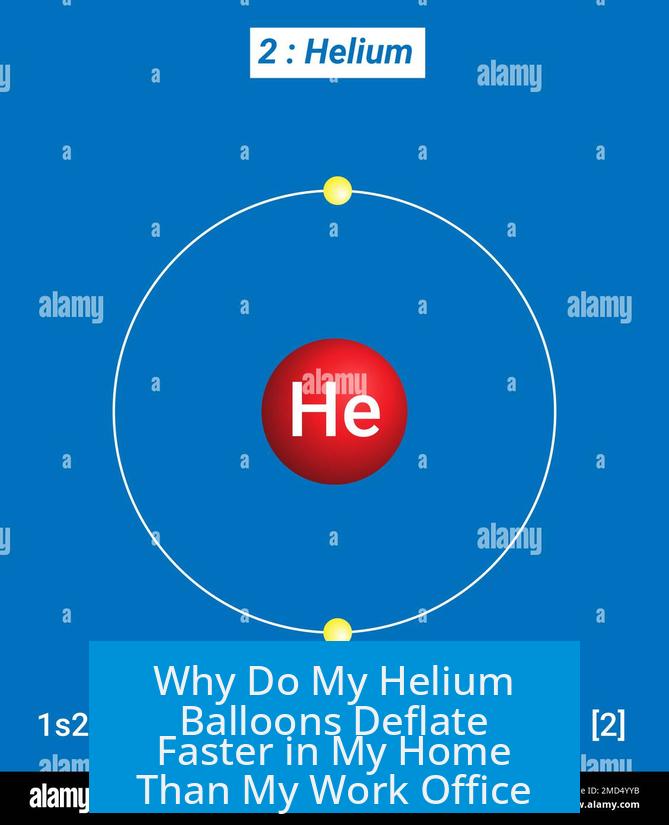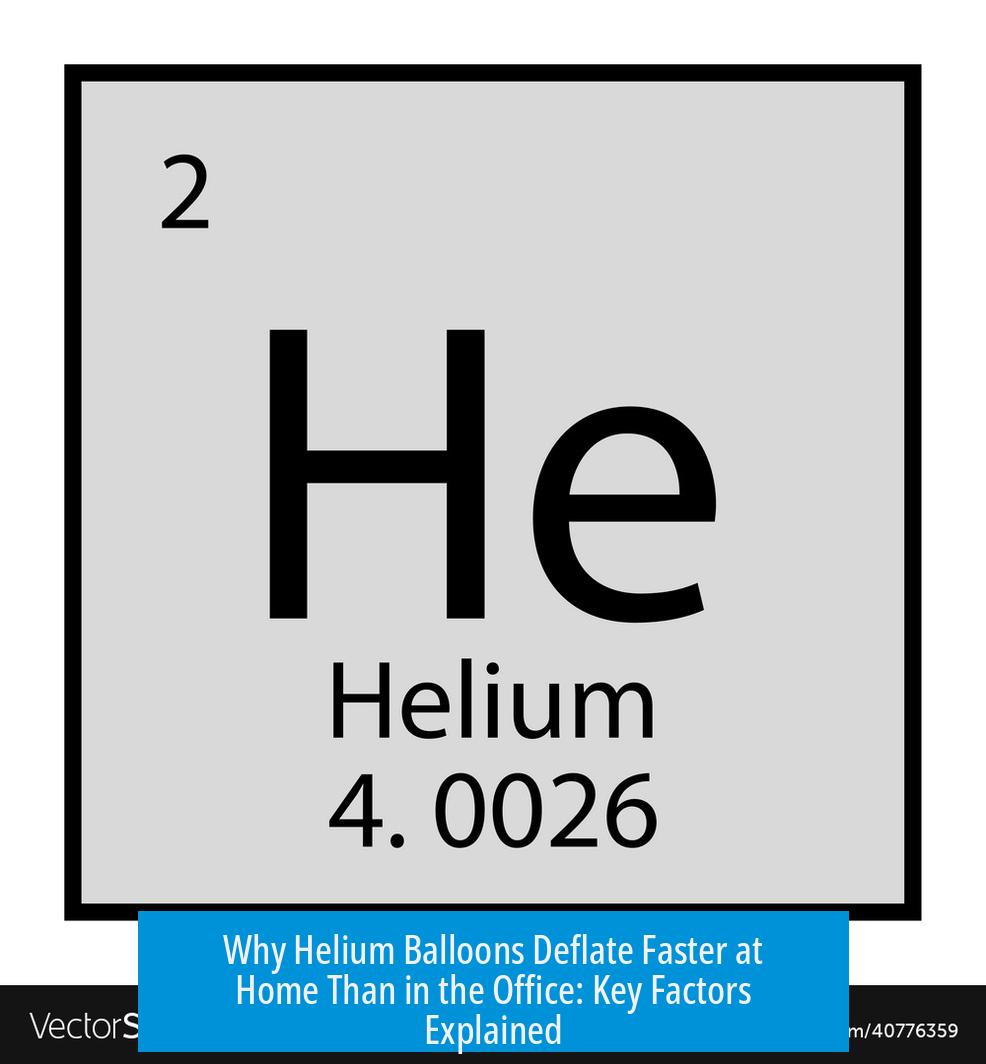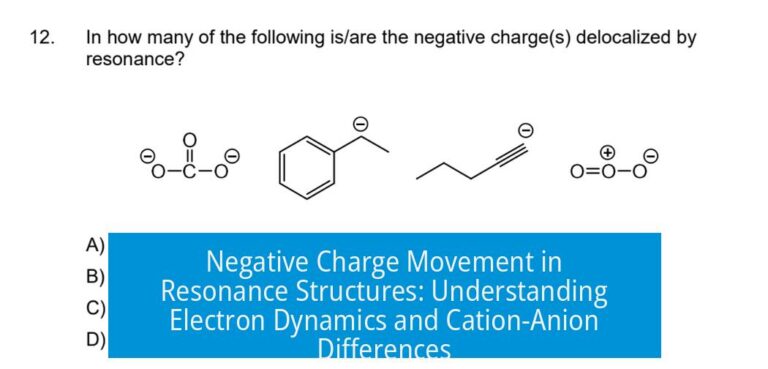Why Do My Helium Balloons Deflate Faster in My Home Than My Work Office?

Helium balloons deflate faster in your home than your work office primarily because of differences in temperature, balloon sealing quality, environmental conditions, and balloon handling. Each of these factors influences the rate at which helium gas escapes through the balloon’s membrane and how physical stress contributes to gas loss.
Understanding Helium Balloon Deflation
Helium is a very small, light gas molecule. It tends to escape from balloons by diffuse permeation through the balloon’s material, usually latex or foil. The balloon’s ability to retain helium depends on properties such as material thickness and seal integrity. Environmental conditions affect how quickly helium atoms leak out. These effects manifest in how long your balloons stay inflated in different locations.
1. Temperature Effects on Helium Loss
Temperature plays a significant role in helium balloon deflation rates.
- Helium gas molecules move faster at higher temperatures.
- Faster molecular movement increases the effusion rate of helium through the balloon membrane.
- If your home is warmer than your office, helium inside the balloons at home escapes more quickly.
This can be explained by basic kinetic theory: gas molecules gain energy as temperature rises, increasing their speed and making them more likely to pass through microscopic holes in the balloon membrane.
2. Balloon Design and Sealing Quality
Not all balloons are made equally. Differences in shape, size, material thickness, and sealing techniques impact helium retention.
- Balloons shaped irregularly may have weak sealing points.
- Manufacturing inconsistencies or packaging changes influence helium tightness.
- The batch of balloons brought home could differ from those at work, causing faster helium leaks due to poorer sealing.
Sealing defects, even slight, create microscopic gaps that speed helium loss. For example, foil balloons generally retain helium longer than latex balloons because foil has much lower helium permeability.
3. Knot and Tying Quality

The way balloons are tied or sealed significantly affects helium retention.
- A poorly tied knot can allow helium to escape rapidly through the neck opening.
- If balloons taken home were tied less securely—perhaps due to fatigue or haste—the helium leak rate increases considerably.
Even minor differences in knot tightness can make a noticeable impact on how long a balloon floats.
4. Environmental Impacts: Air Vents and Vibrations
Where you place the balloon influences helium loss too. Environmental factors include:
- Air vents create airflow that moves balloons.
- Movement and vibration cause physical stress on the balloon’s surface.
- This stress may enlarge microscopic pores, enhancing helium diffusion.
For instance, balloons near an air vent at home may experience continual jostling, which subtly pushes helium out faster than in a stable environment like an office.
5. Variability and Combined Effects
The difference in deflation rates likely stems from a combination of the factors above.
- Temperature, balloon design, knot quality, and environment interact.
- Helium purity and initial fill volume might also vary subtly.
- No single reason fully explains the observation.
This variability suggests one cannot assume just one cause but must consider multiple factors working together.
6. Role of Helium Diffusion through Balloon Material
Helium atoms are exceptionally small and diffuse through latex membranes naturally.
- Latex is porous at a microscopic level, allowing helium to escape.
- Introducing air inside the balloon after filling with helium can slow helium loss.
- Nitrogen and oxygen molecules from air block some pores, reducing helium permeability.
This method of partially filling balloons with air after helium inflation is common in balloon artistry to increase longevity.
7. Hypothesis on Helium Purity
The quality or purity of helium gas can affect balloon performance.
- Impurities or blended gases might alter gas behavior inside balloons.
- Balloons filled at different locations might use helium from different sources.
Although less likely to cause dramatic differences, helium purity variations can have a subtle effect on deflation rates.
8. Experimental Methods to Verify Causes
To determine the exact reason for faster deflation at home, consider performing a controlled experiment:
- Buy identical balloons from the same batch.
- Fill all balloons with equal amounts of helium at the same time, using consistent procedures for tying.
- Place half the balloons in your home and half in your office.
- Measure and record environmental parameters such as temperature, humidity, and air circulation.
- Observe and compare balloon deflation rates over a week or more.
This approach isolates variables like balloon quality, handling, and environment, providing clarity on what causes differences.
Summary Table: Key Factors Affecting Balloon Deflation Rates
| Factor | Effect | Relevance to Home vs. Office |
|---|---|---|
| Temperature | Higher temperature increases helium escape rate | Home is warmer than office → faster deflation at home |
| Balloon Design & Seal | Poor shape/seals increase leaks | Different balloon batches at home vs. office |
| Knot Quality | Loose knots allow helium to escape faster | Tying care may differ; home balloons tied less tightly |
| Environmental Disturbance | Movement/vibrations accelerate gas loss | Air vents at home cause vibrations; office stable |
| Helium Purity | Impurities may change diffusion rates | Possible difference in helium source/fill location |
| Air Introduction | Nitrogen partially blocks helium leakage | Uncommon but affects duration if done |
Key Takeaways
- Helium escapes balloons faster at higher temperatures due to increased molecular speed.
- Balloon material quality and sealing have a large impact on helium retention.
- Proper tying prevents premature helium leakage; even small errors matter.
- Environmental factors like air flow and vibrations influence balloon helium loss.
- The faster balloon deflation at home almost certainly results from multiple interacting factors.
- Controlled experiments can identify which specific factors dominate the difference.
Why do helium balloons deflate faster in my home than in my work office?
Higher temperatures at home cause helium atoms to move faster and escape quicker through the balloon’s latex surface. Warmer air speeds up gas effusion leading to faster deflation.
Can the balloon’s shape or how it’s tied affect how fast it loses helium?
Yes. Balloons with different shapes may seal less effectively. Also, knots that aren’t tight let helium leak out faster. Poor tying can cause quicker deflation.
Do environmental factors like air vents or vibrations at home impact balloon deflation?
Yes. Air vents or vibrations can shake balloons, forcing helium out through tiny leaks. More movement at home might speed up deflation compared to a calmer office.
Does helium purity affect how long a balloon stays inflated?
Helium quality can vary. Cleaner helium may perform differently, but it’s usually a minor factor compared to temperature or balloon sealing.
Will adding air to a helium balloon help it last longer?
Introducing some air slows helium loss. Nitrogen in air plugs tiny holes in the latex, reducing helium diffusion and extending float time.





Leave a Comment